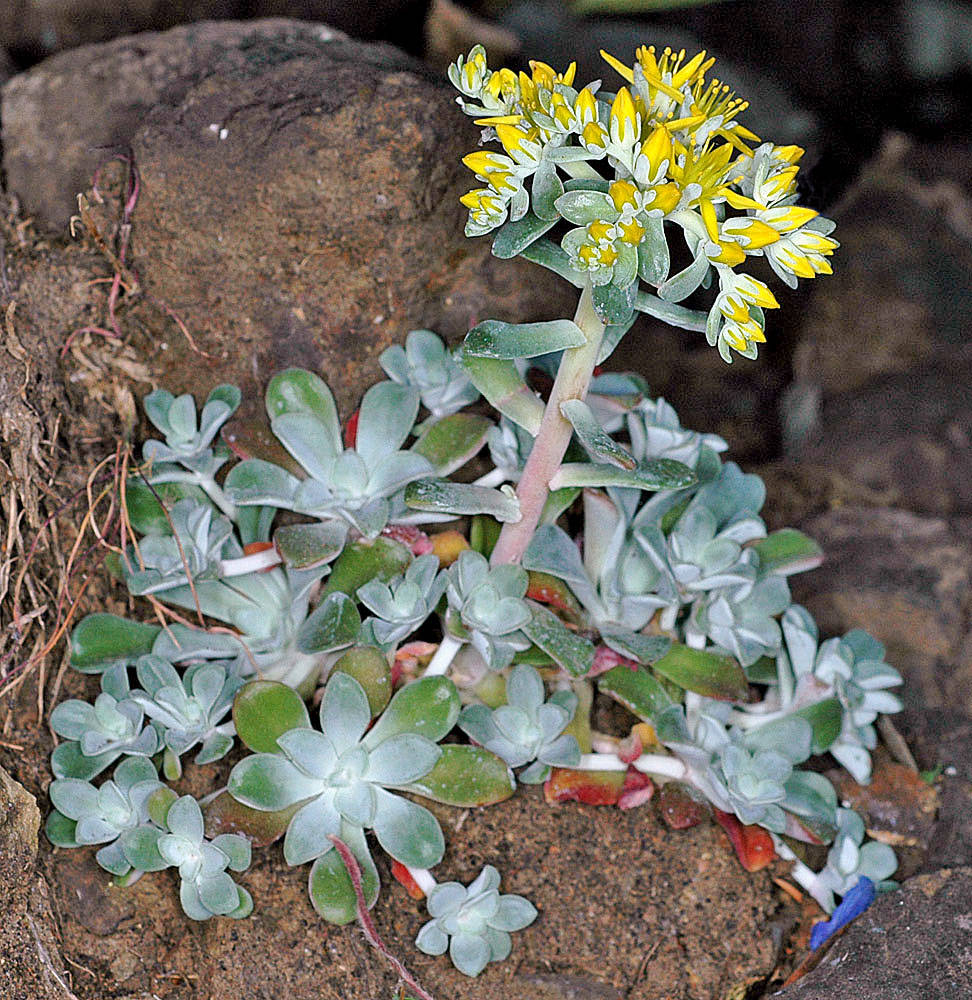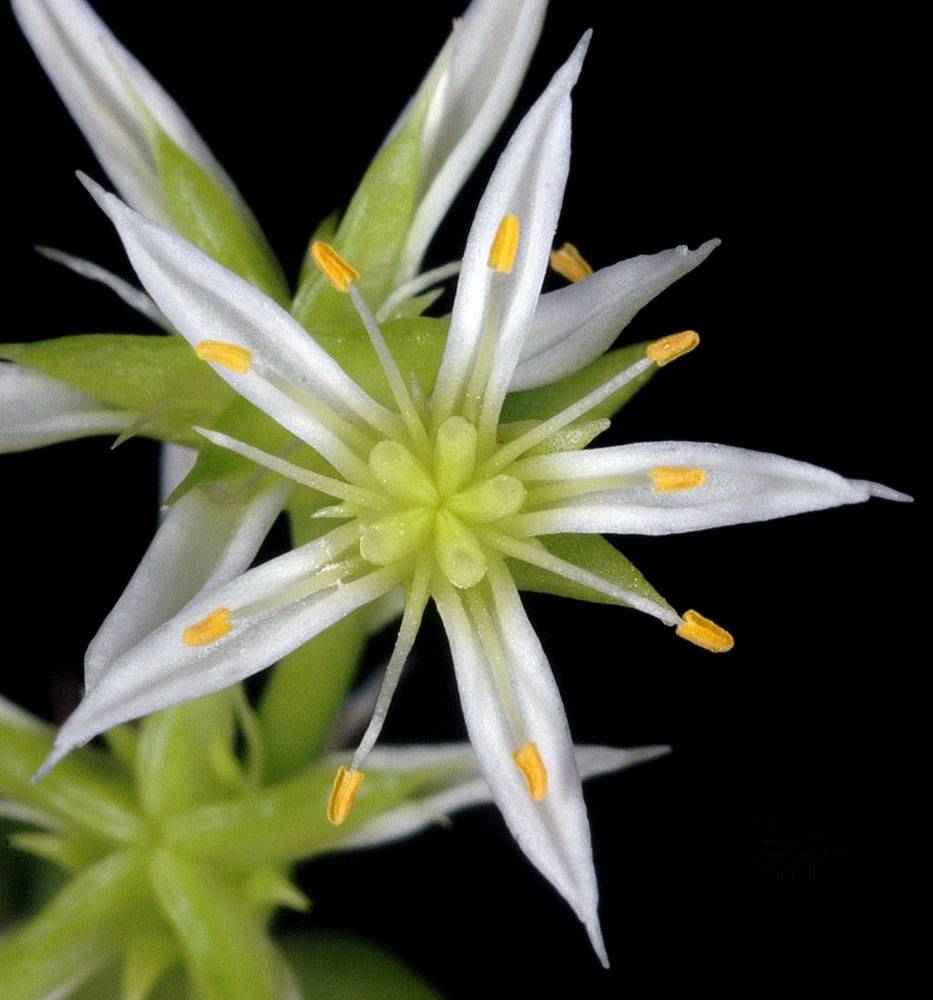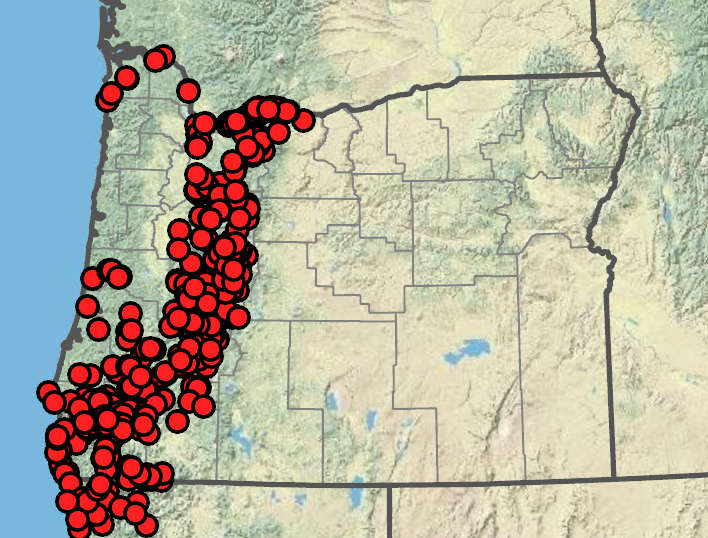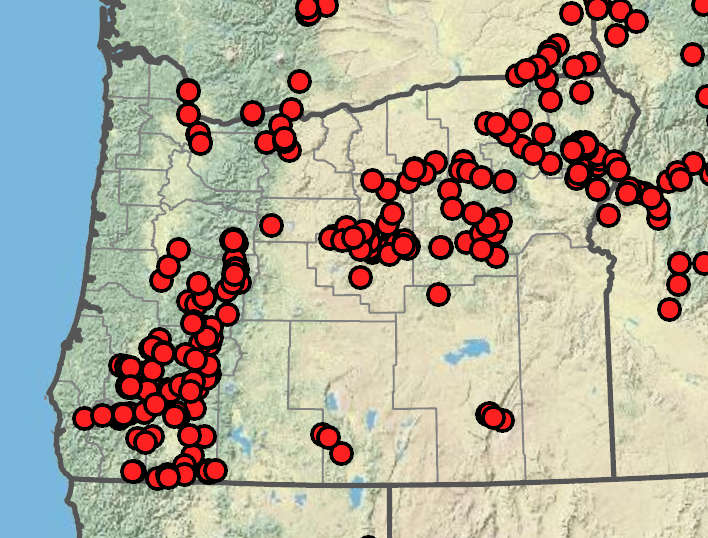Sedum spathulifolium
Sedum stenopetalum
broadleaf stonecrop
wormleaf stonecrop
extensively stoloniferous, with dense terminal rosettes.
decumbent, branched, with terminal rosettes.
erect; simple, 3–14 cm;
stem leaves alternate, spatulate-oblong or elliptic-oblong; widest at or below middle, different from rosette leaves.
erect, branched, 10–43 cm;
stem leaves alternate, linear, with basal scarious spurs and producing offset rosettes in their axils; bulbils present.
rosette leaves spreading, usually nearly parallel to ground, usually forming flat rosettes, spatulate, narrowing to petioles, 7–19 × 4.5–10 mm, 5 × as wide as thick, green or pruinose and white, bases not spurred, not scarious, sometimes muricate or papillose near margins;
tips rounded or truncate;
surfaces usually glaucous.
rosette leaves persistent, spreading to erect, narrowly oblanceolate; narrow and often rounded in cross section, 4.3–13.8 × 1.4–2.7 mm, green to red, bases with small spur;
margins sometimes papillose-ciliate; papillae 0.1–0.15 mm;
tips acuminate or attenuate;
surfaces not glaucous, dried leaves strongly keeled.
cymes with ~30 flowers, 3-branched;
branches forked;
bracts oblong-spatulate or linear.
solitary flowers or small cymes with 9–15(25) flowers, mostly 3-branched;
primary branches sometimes dichotomously forked;
bracts like other leaves but smaller.
5-parted;
sepals spreading to erect, lanceolate, linear-lanceolate, oblong-ovate or obovate; ~2.5 × 1.5 mm, green to yellow-green;
tips acute or obtuse;
surface glaucous or pruinose;
petals strongly spreading above erect base, linear to oblanceolate, 4.5–9 mm, yellow;
tips acute;
filaments yellow;
anthers yellow.
(3)5(8)-parted;
sepals distinct, lanceolate to ovate, 2–3.7 × 0.8–1.7 mm, yellow, yellow-green; greenish, white, or cream-colored;
tips acute or acuminate;
petals spreading horizontally; distinct, lanceolate to elliptic; widest at or below middle, 5.4–11 mm, yellow or white with green or brown;
keel white;
tips obtuse to long-acuminate, sometimes apiculate;
filaments yellow or white;
anthers yellow;
ovaries glandular-pustulose.
erect until mature then spreading, fused basally, brown.
widely spreading when mature, fused near base, light green to brown, papillose, rarely glandular-pustulose.
=64.
Sedum spathulifolium
Sedum stenopetalum
Rocks, cliffs and road cuts. Flowering Apr–Aug. 0–2400 m. Casc, Col, CR, ECas, Est, Sisk, WV. CA, WA; north to British Columbia. Native.
Sedum spathulifolium is highly variable. If subspecies are recognized, most of our plants are S. spathulifolium ssp. spathulifolium. A coastal form with thick, white-pruinose leaves, short, stout stolons, dense inflorescences and thick, crowded stem leaves can be called S. s. ssp. pruinosum (if it is considered a strictly coastal entity). If it is considered to include strongly glaucous or pruinose plants of the Coast Range that are less dense in growth form, the name S. s. var. minus would be applied. Plants with thin, green leaves, numerous long, slender stolons that tend to grow upwards before growing out, paler flowers, and more spreading follicles can be called S. s. ssp. purdyi, a rare form known only from southern Josephine County, and Del Norte and Siskiyou counties in California.
Western North America. 2 subspecies.
Sedum stenopetalum is easily identified by its linear leaves, and by the small rosettes in the axils of all or most of the leaves on the flowering stems. These rosettes may bear more or less deformed, petal-less, terminal flowers. Because plants usually grow from overwintering rosettes that are independent of the parent plant, they usually appear biennial but can be considered clones of long-lived perennials. Plants with a single, terminal flower (sometimes replaced by a rosette), have been segregated as S. stenopetalum ssp./var. monanthum. The range of this putative taxon is completely overlapped by the typical form, and the two are sometimes found in a single population.
Barbara Wilson, Richard Brainerd, Nick Otting
Barbara Wilson, Richard Brainerd, Nick Otting
- Local floras:
BC,
CA,
OR,
WA
- Local Web sites:
CalFlora,
CalPhotos,
Flora NW,
PNW Herbaria,
Turner Photog.
WildflowerSearch
iNaturalist (observations)
USDA Plants Database
- LBJ Wildflower Center
- SEINet
- Plants of the World Online
- Encyclopedia of Life
- Wikipedia
- Google Image Search
- Local floras:
BC,
CA,
OR,
WA
- Local Web sites:
CalFlora,
CalPhotos,
Flora NW,
PNW Herbaria,
Turner Photog.
WildflowerSearch
iNaturalist (observations)
USDA Plants Database
- LBJ Wildflower Center
- SEINet
- Plants of the World Online
- Encyclopedia of Life
- Wikipedia
- Google Image Search





